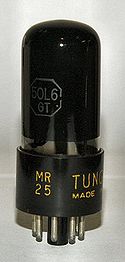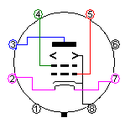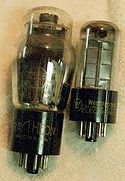
25L6
Encyclopedia

Tube socket
Tube sockets are electrical sockets into which vacuum tubes can be plugged, holding them in place and providing terminals, which can be soldered into the circuit, for each of the pins. Sockets are designed to allow tubes to be plugged in in only one orientation...
vacuum tube
Vacuum tube
In electronics, a vacuum tube, electron tube , or thermionic valve , reduced to simply "tube" or "valve" in everyday parlance, is a device that relies on the flow of electric current through a vacuum...
of the beam-power tetrode
Tetrode
A tetrode is an electronic device having four active electrodes. The term most commonly applies to a two-grid vacuum tube. It has the three electrodes of a triode and an additional screen grid which significantly changes its behaviour.-Control grid:...
type. It found common application in AC/DC radio receivers - such as those of the All American Five
All American Five
The term All American Five is a colloquial name for mass-produced, superheterodyne radio receivers that used five vacuum tubes in their design. These radio sets were designed to receive amplitude modulation broadcasts in the medium wave band, and were manufactured in the United States from the mid...
type - and was also found in large numbers in early computers, such as the UNIVAC I
UNIVAC I
The UNIVAC I was the first commercial computer produced in the United States. It was designed principally by J. Presper Eckert and John Mauchly, the inventors of the ENIAC...
.

This family is not to be confused with the 6L6
6L6
6L6 is the designator for a vacuum tube introduced by Radio Corporation of America in July 1936. At the time Philips had already developed and patented power pentode designs, which were fast replacing power triodes due to their greater efficiency...
which has the same basing diagram
Basing diagram
A basing diagram shows or describes the “pins” of an electronic component. This part usually has more than two pins, so a basing diagram is needed to show which pin does what. Many basing diagrams also show dimensions....
, but has more than twice the power capability of the 25L6.

Computer equipment used this tube as a relay driver or to run the solenoid
Solenoid
A solenoid is a coil wound into a tightly packed helix. In physics, the term solenoid refers to a long, thin loop of wire, often wrapped around a metallic core, which produces a magnetic field when an electric current is passed through it. Solenoids are important because they can create...
s in key punch
Key punch
A keypunch is a device for manually entering data into punched cards by precisely punching holes at locations designated by the keys struck by the operator. Early keypunches were manual devices. Later keypunches were mechanized, often resembled a small desk, with a keyboard similar to a...
machines. The heater in this case ran off the 24 volt power line in the equipment resulting in long life, and slightly lower power output. The industrial type 6046 is a 25L6GT rated for that application.
Also see All American Five
All American Five
The term All American Five is a colloquial name for mass-produced, superheterodyne radio receivers that used five vacuum tubes in their design. These radio sets were designed to receive amplitude modulation broadcasts in the medium wave band, and were manufactured in the United States from the mid...
.

